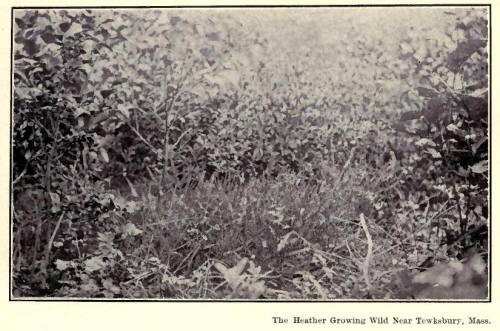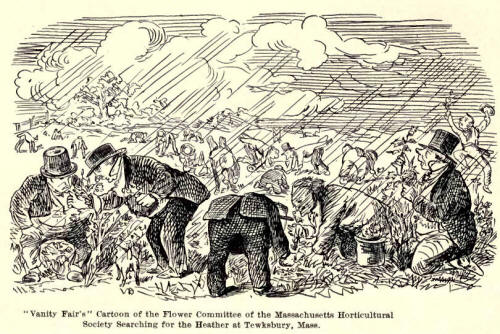|


PROBABLY no plant has been put or is better
adapted to so many utilitarian purposes as the Heather. It has been
correctly stated that to the inmates of the Scottish shieling Heather
stands in much the same relation for its economic uses as does the
bamboo to the Gond or Mandalay. Force of circumstances led to the
discovery of most of these uses. The hardy Highlanders covered their
cabins with Heather instead of thatch, or else twisted it into ropes,
and bound down the thatch with these ropes in a kind of latticework.
They also made the walls of their dwellings with alternate layers of
Heather and a sort of cement made of black earth and straw.
Pennant remarks of the houses in Iona: "Houses are
mostly very mean, thatched with straw of bear pulled up by the roots,
and bound tight on the roof by ropes made of heath."
Boswell thus describes such houses in "Johnson's
Journey of a Tour to the Hebrides": "They (the houses) are thatched,
sometimes with straw, sometimes with heath, sometimes with fern. The
thatch is secured by ropes of heath; and to fix the ropes there is a
stone tied to the end of each. These stones hang around the bottom of
the roof, and make it look like a lady's hair in papers; but I should
think that, when them is wind, they would come down and knock people on
the head."
Johnson himself, in his 'Journey to the Western
Isles," remarks as follows: "Such rafters as can be procured are then
raised for a roof, and covered with heath, which makes a strong and warm
thatch, kept from flying off by ropes of twisted heath, of which the
ends, reaching from the center of the thatch to the top of the wall, are
held firm by the weight of a large stone."
Conditions of building in the Highlands have not
materially changed since Johnson's days. in the '90' edition of
Professor Geikie's admirable work on "The Scenery of Scotland," dealing
with the influences of topography on man, he says: "The houses, built of
boulders gathered from the soil, and held together with mere clay or
earth, are covered with frail roofs of ferns, straw, or Heather, kept
down by stone-weighted ropes of the same material."
This method of construction applied equally to
church and cabin. Dunbar, the poet, who was also a traveling friar,
centered his ambition in a house of worship so covered. He says:
Gait abbais graith I will to gather
But ane
kirk scant covert with hadder;
For I of lytil wad be lane,
Quilk
to consider is ane pane.
Dunbar was led to utter this modest plaint because
"in Papist times the cathedrals absorbed the money and the genius of the
day, and the parish churches, especially in Scotland, were too often
barely thatched with heath."
Chalmers says that even as late as the sixteenth
century the churches were generally covered with thatch. The cathedrals
and abbeys, however, were structures of great labor and expense, of
magnificence and taste, as the judicious eye may perceive in their
ruins.
Logan tells us that many churches were formerly
covered with Heather, some within his own memory, the services from
lands being often a certain quantity of it for this purpose. Its only
disadvantage was in being heavier than straw or rushes. Heather-covered
churches were to be found in Carlyle's days, who fondly refers to one as
"the poor temple of my childhood thatched with heath."
It is recorded in Mclan's history of Clan Drummond
that on one occasion the Heather covering of a church proved disastrous
during an engagement with another clan. The story goes: In the beginning
of the sixteenth century a feud arose with the Murrays, who had
intercepted the rents payable by the tenants of Monievaird, on which
William, then chief, and Duncan Campbell, of Dunstaffnage, went against
them to compel restitution and punish them for their aggression. Not
daring to meet this force, the Murrays retired to the church, and
Drummond, respecting the sanctuary, gave orders to retire; but as they
commenced their march a shot was unhappily fired by which one of the
Campbells was killed, when so enraged were they at this cowardly act,
that they immediately returned, and, not taking the trouble of storming
the sacred edifice, they set fire to its Heather roof and burned to
death the miserable inmates. This was more particularly the crime of the
Campbells, but Drummond was brought to trial for it, and being
pronounced guilty, he was executed in 1511.
A story is told that in ancient days a woman was
fined so many marks by her kirk session for a misdemeanor of which she
had been convicted. One of the stern old pillars of the church did not
agree with the sentence, giving vent to his views as follows: "The
jade'll never pay ye; she's nae guilty o' payin' ony ane; gar (make) her
pit' a few birns o' fine swack Heather to make the kirk water-ticht."
A Heather thatch is most durable; in fact, it is
reckoned to last a lifetime.
|
